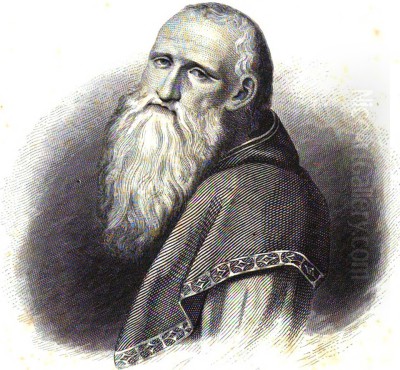
Bernardino Luini stands as one of the most significant painters of the High Renaissance in Lombardy, Northern Italy. Active primarily in Milan and its surrounding regions during the late 15th and early 16th centuries, Luini developed a distinctive style characterized by its gentle grace, serene beauty, and profound devotional feeling. Though often viewed through the lens of his contemporary, the towering figure of Leonardo da Vinci, Luini forged his own artistic identity, blending Leonardesque innovations with Lombard traditions to create works that captivated patrons and continue to resonate with viewers today. His legacy is one of technical skill, emotional sensitivity, and a remarkable prolificacy in both fresco and panel painting.
Uncertain Beginnings: Birth and Early Life
Pinpointing the exact details of Bernardino Luini's early life remains a challenge for art historians, as documentary evidence is scarce and sometimes contradictory. Most scholarly consensus places his birth around 1480 or 1482. The location of his birth, however, is subject to some debate. Strong evidence points towards Dumenza, a small town near Luino on the shores of Lake Maggiore in the Lombardy region. This area, close to the Swiss border, was part of the cultural orbit of Milan.
An alternative tradition suggests he might have been born in Luino itself, a slightly larger town nearby. This confusion may stem from the similarity of the names or the fragmented nature of records from the period. Regardless of the precise location, his origins lie in the vibrant artistic milieu of Renaissance Lombardy. It is generally believed that Luini made his way to the bustling artistic center of Milan around the year 1500, seeking training and opportunities to establish his career as a painter.
Formative Training and Influences
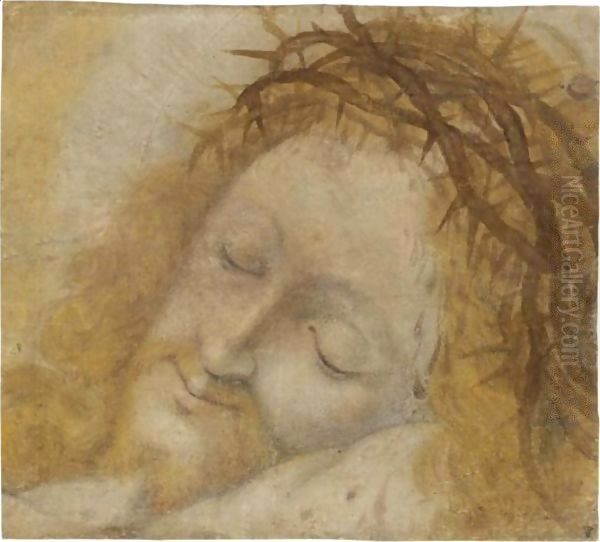
The identity of Luini's first master is another area where certainty eludes us. One prominent theory suggests he initially trained under Ambrogio Bergognone (also known as Ambrogio da Fossano). Bergognone was a leading painter in Milan towards the end of the 15th century, known for his deeply felt religious works and a somewhat conservative style rooted in Lombard traditions, characterized by a delicate realism and often somber piety. Training with Bergognone would have provided Luini with a solid grounding in traditional techniques and the prevailing artistic tastes of the region.
Other possibilities for his early instruction exist. Some sources mention Gian Stefano Scotto as a potential teacher, another Milanese painter active during that period. It is also plausible that Luini received training from other, less documented masters within the Milanese guild system. What is clear is that by the early 16th century, Luini was absorbing the artistic currents flowing through Milan, a city transformed by the recent presence of Leonardo da Vinci and the architectural innovations of Donato Bramante. The artistic environment was rich, also featuring established figures like Vincenzo Foppa, whose influence shaped the earlier generation of Lombard painters like Bergognone, and contemporaries like Bramantino (Bartolomeo Suardi).
The Enduring Shadow of Leonardo da Vinci
The most profound and defining influence on Bernardino Luini's artistic development was undoubtedly Leonardo da Vinci. Leonardo resided in Milan for extended periods, first from 1482 to 1499 and later from 1506 to 1513. His presence revolutionized Milanese art, introducing unprecedented levels of psychological depth, compositional complexity, and technical innovation, most famously his signature sfumato – the subtle blurring of outlines to create soft, atmospheric transitions between tones.
Luini became one of the most prominent and skilled interpreters of Leonardo's style, often referred to as a key member of the Leonardeschi, the circle of followers and students who adopted and adapted the master's manner. Luini masterfully absorbed Leonardo's techniques, particularly the use of sfumato to model forms softly and create an aura of gentle mystery. He adopted Leonardo's interest in capturing subtle emotional states through facial expressions and gestures, though often imbuing them with a sweeter, less intellectually complex quality than the master himself.

The influence is evident in Luini's compositional choices, his preference for certain facial types – particularly the graceful, oval faces of his Madonnas and female saints – and his delicate rendering of light and shadow. So closely did Luini emulate aspects of Leonardo's style that, for centuries, numerous works by Luini were misattributed to Leonardo himself, a testament to Luini's skill in capturing the essence of the Florentine master's innovations while adapting them to his own Lombard sensibility. Other prominent Leonardeschi included Andrea Salai and Francesco Melzi, who inherited Leonardo's notebooks, as well as Marco d'Oggiono.
Collaboration and the Milanese Milieu
Within the circle of Leonardo's followers, Luini appears to have had a particularly close association with Giovanni Antonio Boltraffio (also spelled Beltraffio). Boltraffio, an aristocratic painter slightly older than Luini, was another highly talented student directly associated with Leonardo's studio. Evidence suggests potential collaboration between Luini and Boltraffio, and their styles certainly share affinities, particularly in their refined execution and psychological sensitivity, learned under Leonardo's tutelage.
Working within the vibrant artistic community of Milan, Luini would have been aware of the work of other contemporaries. The legacy of earlier Lombard masters like Vincenzo Foppa provided a foundation of regional realism and devotional intensity. The presence of Bramante, primarily an architect but a figure who profoundly impacted the Renaissance aesthetic in Milan, contributed to an atmosphere of classical revival and spatial experimentation. Painters like Bramantino explored monumental forms and sometimes stark perspectives, offering a different artistic path within the same city. Luini navigated these currents, integrating the groundbreaking approach of Leonardo with the enduring traditions and tastes of his Lombard patrons.
A Prolific Career: Frescoes and Panel Paintings
Bernardino Luini was an exceptionally productive artist, leaving behind a substantial body of work in both fresco and oil on panel. He received numerous commissions from churches, monastic orders, and private patrons throughout Milan and the surrounding Lombard region. His reputation grew steadily, making him one of the most sought-after painters in the area during the first three decades of the 16th century.
His fresco work is particularly noteworthy. He executed extensive decorative cycles in several important religious sites. Among his most celebrated fresco projects are those in the church of San Maurizio al Monastero Maggiore in Milan, often called the "Sistine Chapel of Milan," where he painted scenes from the lives of saints and biblical narratives with remarkable narrative clarity and decorative elegance. He also worked at the Sanctuary of the Beata Vergine dei Miracoli in Saronno, contributing significantly to its rich interior decoration. Other locations associated with his frescoes include the Abbey of Chiaravalle and Santa Maria della Passione in Milan.
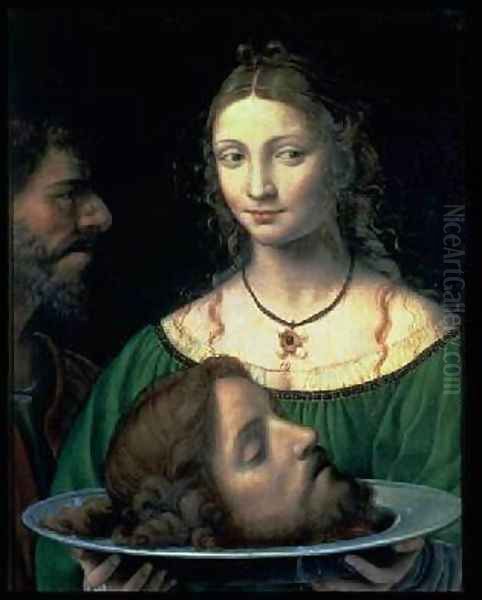
Alongside his monumental fresco cycles, Luini was a master of panel painting, producing numerous altarpieces and smaller devotional works. These paintings, often depicting the Madonna and Child, the Holy Family, or individual saints, were prized for their refined execution, gentle piety, and appealing beauty. His skill in rendering textures, from soft fabrics to luminous skin, combined with his harmonious color palettes, made his panel paintings highly desirable.
Key Representative Works
Luini's extensive oeuvre includes many masterpieces that exemplify his style. Among his most famous and representative works are:
Madonna of the Rose Hedge (Madonna del Roseto): Housed in the Pinacoteca di Brera in Milan, this iconic work is perhaps the quintessential example of Luini's gentle style. The Virgin Mary and Child are depicted in a serene garden setting, framed by a hedge of roses. The soft sfumato, the tender interaction between mother and child, and the overall atmosphere of tranquil devotion make it one of his most beloved paintings.
Christ Crowned with Thorns: This powerful fresco, part of the cycle in San Maurizio al Monastero Maggiore, showcases Luini's ability to convey deep emotion and pathos. The depiction of Christ's suffering is rendered with sensitivity, avoiding excessive gore while emphasizing the spiritual and psychological weight of the moment.
Holy Family with St. Anne and the Young St. John: Variations of this theme exist, demonstrating Luini's skill in handling multi-figure compositions. These works often display a tender domesticity and explore the complex relationships within the holy family, influenced by Leonardo's own explorations of the subject but imbued with Luini's characteristic sweetness.
Madonna and Child with St. George and the Musician Angels: This panel painting highlights Luini's ability to combine devotional intimacy with elements of courtly elegance. The figures are gracefully posed, the details meticulously rendered, and the inclusion of musical angels adds a lyrical quality typical of his work.
Christ Disputing with the Doctors: Now in the National Gallery, London, this painting was famously attributed to Leonardo da Vinci for a long period. It shows the young Christ engaged in learned debate, demonstrating Luini's mastery of Leonardesque composition and facial types, which led to the confusion over its authorship.
Madonna with Child and Saints Sebastian and Roche: This work exemplifies Luini's skill in creating balanced compositions featuring saints alongside the central figures of Mary and Jesus. The gazes and gestures create a quiet dialogue between the figures, typical of his narrative subtlety.
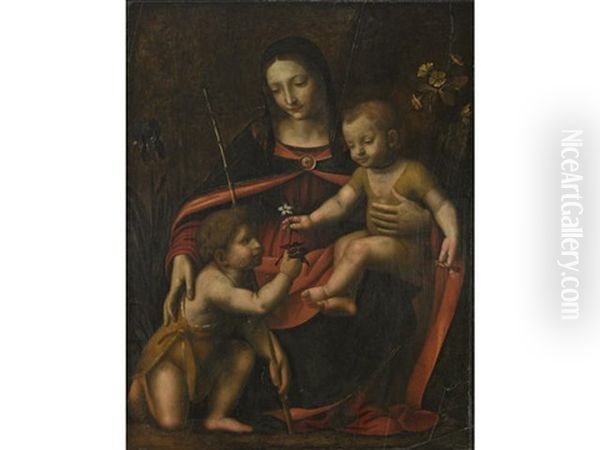
These works, among many others, illustrate the core characteristics of Luini's art: technical refinement, emotional accessibility, harmonious composition, and a pervasive sense of gentle piety.
The Distinctive "Luinesque" Style
Over time, Luini's particular interpretation of the Leonardesque manner coalesced into a recognizable style often termed "Luinesque." This style is defined by several key characteristics. Foremost among these is the depiction of female figures, especially Madonnas and saints, with idealized, sweet faces, often characterized by oval shapes, delicate features, and distinctively elongated, heavy-lidded eyes that frequently cast a downward or slightly averted gaze, conveying modesty and serene contemplation.
The application of sfumato in Luini's work, while learned from Leonardo, often results in a softer, almost mistier effect, contributing to the dreamlike and gentle quality of his paintings. His color palettes tend towards harmonious and sometimes rich combinations, but always balanced to maintain an overall sense of tranquility. While capable of depicting intense emotion, as seen in his Passion scenes, the prevailing mood in much of Luini's work is one of calm, grace, and approachable divinity.
Compared to Leonardo's profound intellectualism and psychological complexity, Luini's art often presents a more direct, perhaps more decorative, appeal. He translated the sophisticated innovations of his master into a visual language that was highly appealing to the devotional needs and aesthetic preferences of his Lombard patrons. His figures possess an elegance and refinement that became a hallmark of the Lombard school during the High Renaissance.
Evolving Influences: The Impact of Raphael
While Leonardo da Vinci remained the foundational influence throughout Luini's career, evidence suggests that in his later years, he also became receptive to artistic developments emanating from Rome, particularly the work of Raphael. Raphael's art, characterized by its classical balance, idealized beauty, and harmonious compositions, offered a different model of High Renaissance perfection.
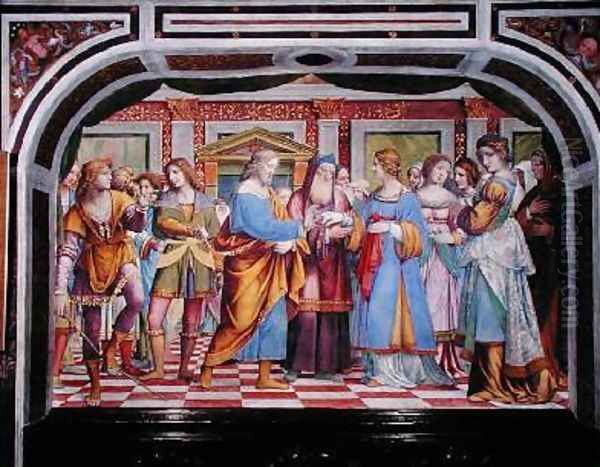
In some of Luini's later works, art historians detect a shift towards slightly clearer forms, perhaps brighter colors, and compositions that echo Raphaelesque principles of grace and order. This does not represent a wholesale abandonment of his Leonardesque roots but rather an assimilation of new ideas into his established style. This openness to evolving trends reflects Luini's position within the broader currents of Italian Renaissance art, where artists constantly observed, learned from, and responded to the innovations of their contemporaries across different regional centers. This late-career absorption of Raphaelesque elements can be seen as a subtle move towards the emerging ideals of classicism.
Legacy, Misattribution, and Rediscovery
Bernardino Luini died in Milan in 1532, leaving behind a rich artistic legacy and a workshop likely continued by his sons. In the centuries immediately following his death, his reputation remained strong, particularly in Lombardy. However, his fame was often intertwined with, and sometimes overshadowed by, that of Leonardo da Vinci. The remarkable similarity in style led to the persistent misattribution of many of Luini's finest works to Leonardo, particularly during the 17th and 18th centuries when connoisseurship was less developed. This confusion, while highlighting Luini's skill, paradoxically obscured his individual identity for a time.
A significant re-evaluation of Luini's work began in the 19th century. Critics and art historians started to disentangle his oeuvre from Leonardo's and appreciate his unique contributions. The influential English writer John Ruskin, known for his passionate and sometimes idiosyncratic judgments, became a great admirer of Luini. Ruskin famously, if controversially, praised Luini's spiritual purity and emotional sincerity, even suggesting he surpassed Leonardo in certain aspects, calling him "ten times greater than Leonardo." While hyperbolic, Ruskin's advocacy helped restore Luini's name and draw attention to the quality and beauty of his art.
Today, Bernardino Luini is firmly recognized as a major figure of the Lombard Renaissance. His works are housed in prestigious museums worldwide, including the Pinacoteca di Brera in Milan, the National Gallery in London, the Louvre in Paris, the Kunsthistorisches Museum in Vienna, and the National Gallery of Art in Washington D.C., as well as in the churches and sanctuaries for which they were originally created. His art continues to be studied for its technical mastery, its sensitive interpretation of religious themes, and its embodiment of the graceful Lombard aesthetic.
Conclusion: A Master of Lombard Grace
Bernardino Luini occupies a crucial place in the history of Italian Renaissance art. As one of the most gifted and sensitive followers of Leonardo da Vinci, he played a vital role in disseminating the master's style throughout Lombardy. Yet, Luini was more than just an imitator. He skillfully synthesized Leonardo's innovations with the existing artistic traditions of his region and his own innate sense of grace and piety.
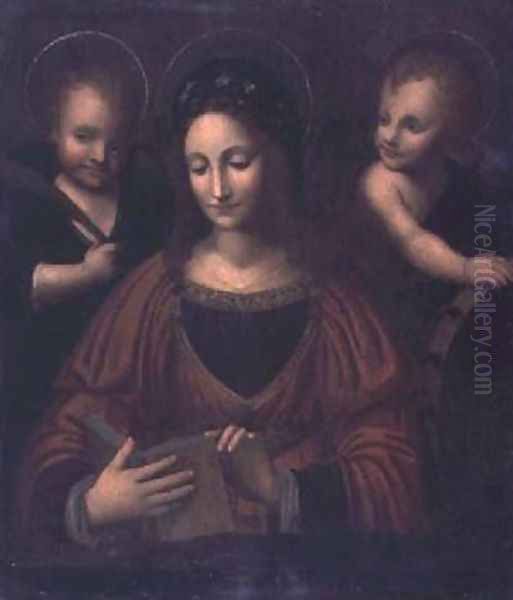
His prolific output, particularly his serene Madonnas, his elegant female saints, and his extensive fresco cycles, defined a particular strain of Lombard art characterized by its gentle beauty, emotional accessibility, and refined execution. The "Luinesque" style, with its soft modeling, sweet expressions, and tranquil moods, represents a distinct and appealing contribution to the High Renaissance. Though sometimes overshadowed by the giants of his era like Leonardo, Raphael, and Michelangelo, Bernardino Luini remains a master in his own right, an artist whose works continue to offer viewers a vision of serene devotion and timeless grace.